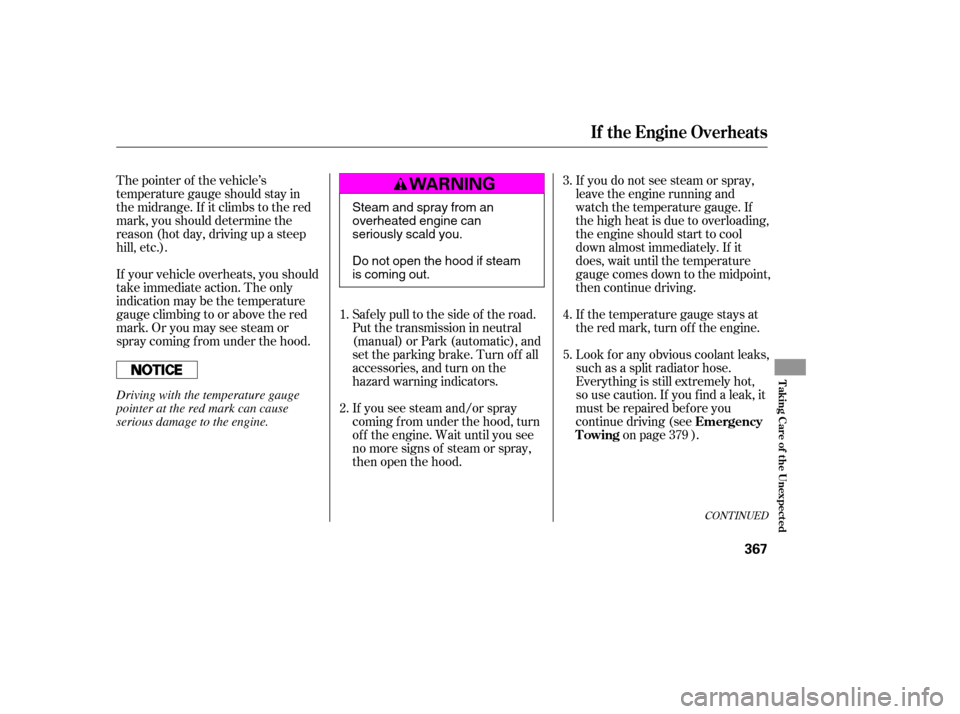Page 380 of 436

CONT INUED
Park the vehicle on f irm, level and
non-slippery ground. Put the
transmission in Park (automatic)
or reverse (manual). Apply the
parking brake.
If you have a f lat tire while driving,
stop in a saf e place to change it.
Drive slowly along the shoulder until
you get to an exit or an area that is
far away from the traffic lanes.
Turn on the hazard warning lights,
and turn the ignition switch to the
LOCK (0) position. Have all
passengers get out of the vehicle
while you change the tire.
The tools are in the trunk. Open
the trunk and raise the trunk f loor
by lif ting up on the back edge.
Take the tool kit out of the trunk.
Unscrew the wing bolt and take
the spare tire out of its well.
5.
4.
3.
2.
1.
Changing a Flat T ire
T aking Care of t he Unexpect ed
357
TRUNK FLOOR JACK
SPARE TIRE TOOL KIT
The vehicle can easily roll off
the jack, seriously injuring
anyone underneath.
Follow the directions for
changing a tire exactly, and
never get under the vehicle
when it is supported only by thejack.
�����—�����—�����y�
�������������y���
�)�������
���y���������y
Page 385 of 436

Diagnosing why the engine won’t
start f alls into two areas, depending
on what you hear when you turn the
ignition switch to the START (III)
position:You hear nothing, or almost
nothing. The engine’s starter
motor does not operate at all, or
operates very slowly.
You can hear the starter motor
operating normally, or the starter
motor sounds like it is spinning
f aster than normal, but the engine
does not start up and run. When you turn the ignition switch to
the START (III) position, you do not
hear the normal noise of the engine
trying to start. You may hear a
clicking sound, a series of clicks, or
nothing at all.
Check these things:
Check the transmission interlock.
If you have a manual transmission,
the clutch pedal must be pushed
all the way to the f loor or the
starter will not operate. With an
automatic transmission, it must be
in Park or neutral.
Turn the ignition switch to the ON
(II) position. Turn on the
headlights, and check their
brightness. If the headlights are
very dim or do not come on at all,
the battery is discharged. See on page . Turn the ignition switch to the
START (III) position. If the
headlights do not dim, check the
condition of the f uses. If the f uses
areOK,thereisprobably
something wrong with the
electrical circuit f or the ignition
switch or starter motor. You will
need a qualif ied mechanic to
determine the problem (see
on page ).
If the headlights dim noticeably or
go out when you try to start the
engine, either the battery is dis-
charged or the connections are
corroded. Check the condition of
the battery connections (see page ). You can then try jump
starting the vehicle from a booster
battery (see page ).
364 379
351 364
If theEngineWon’tStart
Nothing Happens or the Starter
Motor Operates Very Slowly
Jump Starting Emergency T owing
362
�����—�����—�����y�
�������������y���
�)�������
���y���������y
Page 387 of 436

Although this seems like a simple
procedure, you should take several
precautions. Open the hood, and check thephysical condition of the battery.
In very cold weather, check the
condition of the electrolyte. If it
seems slushy or f rozen, do not try
jump starting until it thaws.
To jump start your vehicle:
Turn of f all the electrical
accessories: heater, A/C, audio
system, lights, etc. Put the
transmission in neutral (manual)
or Park (automatic), and set the
parking brake.
You cannot start your vehicle with an
automatic transmission by pushing
or pulling it. The numbers in the illustrations
show you the order to connect the
jumper cables.
1. 2.
Jump Starting
364
2.4engine models
BOOSTER BATTERY
A battery can explode if you do
not follow the correct procedure,
seriously injuring anyonenearby.
Keep all sparks, open flames,
and smoking materials away
from the battery. If a battery sits in extreme cold, the
electrolyte inside can f reeze.
Attempting to jump start with a f rozen
battery can cause it to rupture.
�����—�����—�����y�
�������������y���
�)�������
���y���������y
Page 388 of 436
�´�´ �µ
CONT INUED
Connect one jumper cable to the
positive ( ) terminal on your
battery. Connect the other end to
the positive ( ) terminal on the
booster battery.Connect the second jumper cable
to the negative ( ) terminal on
the booster battery. Connect the
other end to the engine mounting
bolt (automatic) or the
transmission mounting bolt
(manual),asshown.Donot
connect this jumper cable to any
other part of the engine.
3.
4.2.4engine models
Jump Starting
T aking Care of t he Unexpect ed
365
V6 models BOOSTER BATTERY2.4engine models with automatic
transmission 2.4engine models with manual
transmission
�����—�����—�����y�
�������������y���
�)�������
���y���������y
Page 390 of 436

If you do not see steam or spray,
leave the engine running and
watch the temperature gauge. If
the high heat is due to overloading,
the engine should start to cool
down almost immediately. If it
does, wait until the temperature
gauge comes down to the midpoint,
then continue driving.
If the temperature gauge stays at
the red mark, turn off the engine.
Look f or any obvious coolant leaks,
such as a split radiator hose.
Everything is still extremely hot,
so use caution. If you f ind a leak, it
must be repaired bef ore you
continue driving (seeon page ).
The pointer of the vehicle’s
temperature gauge should stay in
the midrange. If it climbs to the red
mark, you should determine the
reason (hot day, driving up a steep
hill, etc.).
If your vehicle overheats, you should
take immediate action. The only
indication may be the temperature
gauge climbing to or above the red
mark. Or you may see steam or
spray coming f rom under the hood.
If you see steam and/or spray
coming f rom under the hood, turn
of f the engine. Wait until you see
no more signs of steam or spray,
then open the hood.
Saf ely pull to the side of the road.
Put the transmission in neutral
(manual) or Park (automatic), and
set the parking brake. Turn of f all
accessories, and turn on the
hazard warning indicators.
1. 2. 3. 4. 5.
379
CONT INUED
Emergency
Towing
If theEngineOverheats
T aking Care of t he Unexpect ed
367
Steam and spray from an
overheated engine can
seriously scald you.
Do not open the hood if steam
is coming out.
Driving with the temperature gauge
pointer at the red mark can cause
serious damage to the engine.
�����—�����—�����y�
���������
���y���
�)�������
���y���������y
Page 402 of 436

�µ�µ
If your vehicle needs to be towed,
call a prof essional towing service or
organization. Never tow your vehicle
with just a rope or chain. It is very
dangerous.
The operator
loads your vehicle on the back of a
truck.
Therearetwowaystotowyour
vehicle: If , due to damage, your vehicle must
be towed with the f ront wheels on
the ground, do this:
Release the parking brake.
Shif t the transmission to neutral.
Leave the ignition switch in the
ACCESSORY (I) position so the
steering wheel does not lock. With the f ront wheels on the ground,
do not tow the vehicle more than 50
miles (80 km), and keep the speed
below35mph(55km/h).
The tow
truck uses two pivoting arms that go
under the f ront tires and lif t them of f
the ground. The rear tires remain on
the ground.
Leave the ignition switch in the
ACCESSORY (I) position so the
steering wheel does not lock.
Turn of f the engine.
Release the parking brake.
Shif t to D position f or 5 seconds,
then to N.
Start the engine.
Press on the brake pedal. Move
the shif t lever through all its
positions.
Manual transmission:
Automatic transmission:
CONT INUED
Flat -bed EquipmentWheel-lif t Equipment
T his is the best way to
transport your vehicle.
This is an acceptable
way to tow your vehicle.
Emergency T owing
T aking Care of t he Unexpect ed
379
Improper towing preparation will
damage the transmission. Follow the
above procedure exactly. If you cannot
shif t the transmission or start the
engine (automatic transmission), your
vehicle must be transported with the
f ront wheels of f the ground.
�����—�����—�����y�
�������������y���
�)�������
���y���������y
Page 405 of 436
The transmission number is on a
label on top of the transmission.
The engine number is stamped on
the f ront of the engine block.
Identif ication Numbers
T echnical Inf ormation
383
ENGINE NUMBER
2.4
engine models
V6 models AUTOMATIC TRANSMISSION NUMBER
ENGINE NUMBER
AUTOMATIC
TRANSMISSION
NUMBER
MANUAL TRANSMISSION NUMBER
�����—�����—�����y�
������
������y���
�)�������
���y���������y
Page 406 of 436

�µ�µ�Î �Î
�Î�Î
�Î �Î
�Î �Î
Specif icat ions (2.4engine models)
384
Dimensions
Seating Capacities
Capacities
Weights
Air Conditioning
Engine 110.2 in (2,800 mm)
62.6 in (1,590 mm)
Length
Width
Height
Wheelbase
Track
194.1 in (4,930 mm)
72.7 in (1,847 mm)
58.1 in (1,475 mm)
4.8 US qt (4.5
)
2.6 US qt (2.5)
6.9 US qt (6.5
)
2.6 US qt (2.5)
2.1 US qt (2.0)
2.0 US qt (1.9)
5.6 US qt (5.3)
4.2 US qt (4.0)
4.4 US qt (4.2)
2.11 US gal (8.0
)
2.14 US gal (8.1)
1.56 US gal (5.9
)
1.59 US gal (6.0)
5 23
62.2 in (1,580 mm) Total
FrontRear
Fuel tank
Engine
coolant
Engine oil
Manual trans-
mission fluidAutomatic
transmission
fluid
Windshield
washer
reservoir
Including the coolant in the reserve tank and that remaining in the
engine
Reserve tank capacity: 0.180 US gal (0.68
)
Excluding the oil remaining in the engine
Gross vehicle weight rating See the certification label attached
to the driver’s doorjamb.
Refrigerant type
Charge quantity
Lubricant type HFC-134a (R-134a)
14.1 15.9 oz (400 450 g)
ND-OIL8
Water cooled 4-stroke
DOHC i-VTEC 4-cylinder gasoline engine
3.43 x 3.9 in (87.0 x 99.0 mm) 144 cu-in (2,354 cm
)
10.5 : 1
ILZKR7B11S SXU22HCR11S
Type
BorexStroke
Displacement
Compression ratio
Spark plugs (U.S.)
Spark plugs (Canada)
SXU22HCR11S
ILZKR7B11S
DILZKR7A11GS 18.5 US gal (70.0
)
Approx.
Change Manual Automatic
Total ManualAutomatic
1: 2:
NGK:
DENSO: Change
Including filter
Without filter
Total
ChangeTotal
ChangeTotal U.S.
Canada
Front/Rear
ULEV PZEV
1: 2: EX,EX-L
NGK:NGK:
DENSO:
LX, LX-P1 2
1 2
�����—�����—�����y�
������
������y���
�)�������
���y���������y